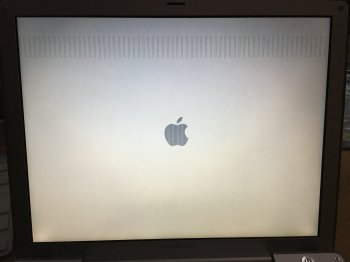First: Powerbook G4 12" display problem:
Need some help. Got a cheap 12" Powerbook G4 at the bay primarily for spare parts - sold as defect with stripes on the display. Came in in great shape with a decent battery and 1GB RAM brick.
I booted it with the help of my own working 12" Powerbook G4, which was set into Target-Disk-Mode. Display shows stripes. I could select and launch any firewire-booting drive and the grey Apple-logo appears. At the point, when the login-screen should come up, the screen turns black. At one occasion, when I booted the Powerbook with the help of the original installation DVD the display went black with flickering red spots all over the display. An attached external monitor shows the same picture.
Any idea how to localize the problem (GPU/InverterBoard/Cable)? I presume it's not a problem of the screen, since the attached external screen shows the same problem.
Here some pictures ...
![IMG_4532.JPG IMG_4532.JPG]()
![IMG_4534.JPG IMG_4534.JPG]()
Second: Powermac G4 doesn't boot
Then I've got that single core Powermac G4 733MHz (Digital Audio). Power supply is ok.
The ADC-connected Cinema Display get's power (and I can even put the PM into sleeping mode via display button too) but I can only hear the booting chime but the display stays black.
Need some help. Got a cheap 12" Powerbook G4 at the bay primarily for spare parts - sold as defect with stripes on the display. Came in in great shape with a decent battery and 1GB RAM brick.
I booted it with the help of my own working 12" Powerbook G4, which was set into Target-Disk-Mode. Display shows stripes. I could select and launch any firewire-booting drive and the grey Apple-logo appears. At the point, when the login-screen should come up, the screen turns black. At one occasion, when I booted the Powerbook with the help of the original installation DVD the display went black with flickering red spots all over the display. An attached external monitor shows the same picture.
Any idea how to localize the problem (GPU/InverterBoard/Cable)? I presume it's not a problem of the screen, since the attached external screen shows the same problem.
Here some pictures ...


Second: Powermac G4 doesn't boot
Then I've got that single core Powermac G4 733MHz (Digital Audio). Power supply is ok.
The ADC-connected Cinema Display get's power (and I can even put the PM into sleeping mode via display button too) but I can only hear the booting chime but the display stays black.
Last edited:


